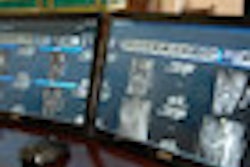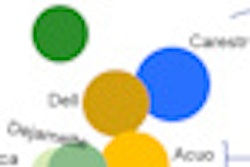A single 6-megapixel (MP) medical display allows for increased radiologist productivity and reduces eye strain during reading sessions compared with two 3-MP displays, researchers from Montefiore Medical Center have found.
Although the study is still ongoing, early results have shown shorter reading time and less eye strain for radiologists when using the 6-MP display, said Mony Weschler, chief strategist at Montefiore. He discussed the preliminary findings during a scientific session at the recent RSNA 2012 meeting in Chicago.
"What we are already seeing is a significant improvement with [the 6-MP display]," Weschler said. "The productivity gains are really quite nice."
The researchers sought to determine whether a single 6-MP medical display system could increase radiologist productivity compared to a dual 3-MP display system. As a secondary goal, the study team wanted to evaluate whether a single 6-MP medical display system reduces eye strain.
The group compared a 6-MP DL LED display (Coronis Fusion, Barco), which allows viewing of two 3-MP images on a single panel, with two separate 3-MP displays (Coronis, Barco). The institution was in the process of replacing its prior displays with the 6-MP displays, and the study also helped serve as justification for continued investment in medical displays, Weschler said.
All displays were categorized and DICOM compliance was verified for the study, Weschler said. Calibration was also performed on all systems.
Eight radiologists initially participated in the study and performed their regular reading tasks using their normal workflow. Both displays were available in the reading rooms, so radiologists could use the two models at will, he said.
At the end of each reading session, the radiologists completed a feedback form that included the radiologist ID, the display ID, and timing information. Details about the cases read during the session were also included. Radiologists also provided qualitative feedback about the display system they were using.
Weschler noted that the clinical study is still ongoing and more feedback forms will be received and processed in the future.
"We definitely have some interesting trends that we are seeing," Weschler said.
Initial analysis has focused on grayscale studies with computed radiography (CR), he said. Not enough cases for other modalities have been read to reach a conclusion.
The 6-MP display caused less eye strain for long reading sessions compared with the 3-MP display, Weschler said. In addition, the average time per CR case was 148 seconds on the 6-MP display, compared with 183 seconds on the dual 3-MP displays.
The researchers plan to continue the clinical study and collect more data to confirm the statistically significant productivity gains of around 19% for 6-MP displays over 3-MP models, he said. They will also continue to evaluate the display's effect on eye strain.
"Physicians are saying that it's easier on their eyes to read on the [6-MP display]," Weschler said.
They will also study the 6-MP display's productivity effect for modalities other than CR, and analyze other subjective questions, he said.



















